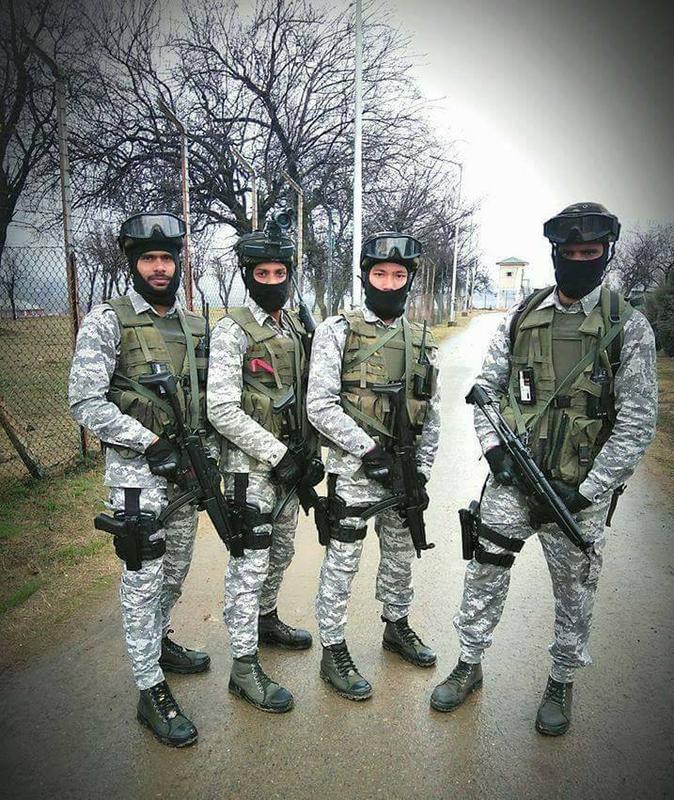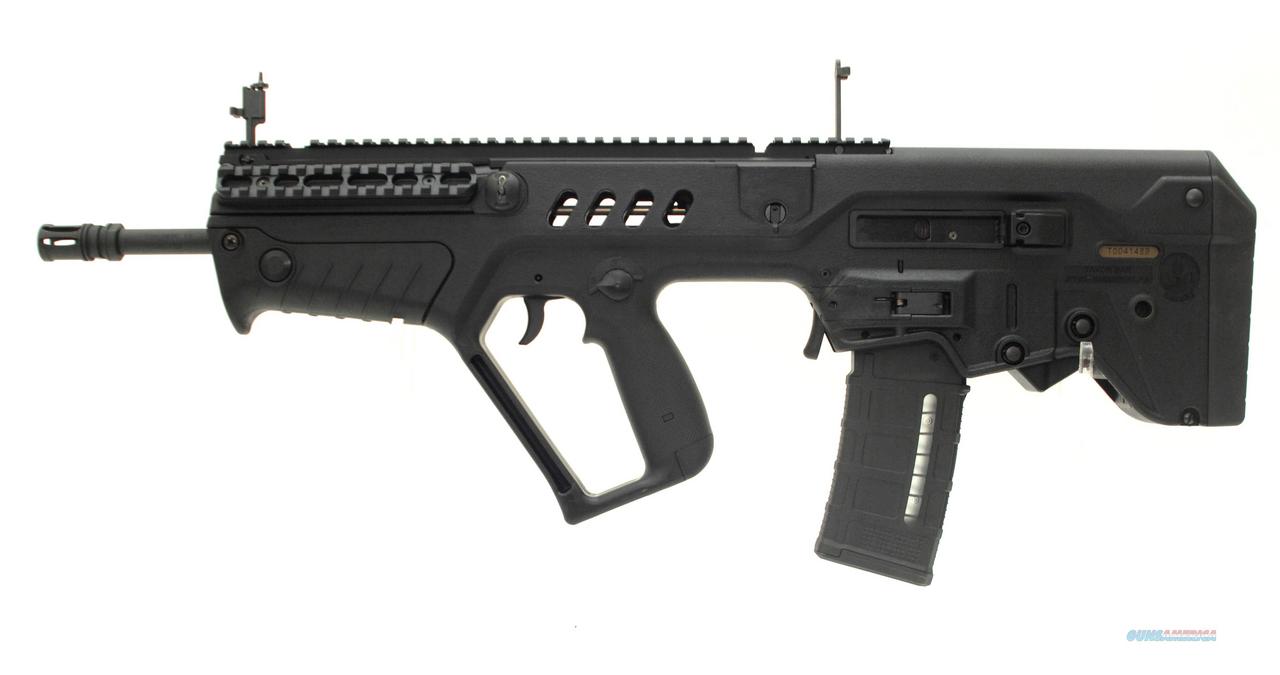The Tavor family of assault rifles has seen, perhaps the most widespread use among the various Special Forces and paramilitary units of India, compared to any other foreign rifle in recent times (save for the ubiquitous and never-dying Kalashnikov)…making it just a few steps short of gaining SLR-like status and renown among armed units in India (those steps I’ve explained in the last part of this article).

First off, a little bit about the rifle itself and it’s Israeli history:
The Tavor is a bullpup design with a long-stroke piston, with the charging handle on the left side and an ambidextrous design overall (with ejection ports provided on both sides, enabling the conversion of a right-handed operation to a left-handed one on the same rifle with just a partial disassembly of the receiver). All Tavor variants produced so far are chambered for the 5.56x45mm NATO round as standard – although variants that can accept 9x19mm and Russian 5.45x39mm feed also exist, but mainly for the civilian market. The bullpup concept was adopted for it’s ability to provide carbine-esque dimensions of the gun body whilst still being able to attain the higher muzzle velocities, effective range and accuracy afforded by having a longer barrel – with a bullpup, one can have a rifle-length barrel attached to a carbine-length gun body.
The first successful iteration of the family, the TAR-21 (standing for Tavor Assault Rifle – 21st Century), was designed by a (then known as) Israel Military Industries (IMI) team lead by Zalmen Shebs, beginning in 1995 – with the intent of providing a more compact, more reliable and easier-to-maintain replacement for the M4 carbines used as standard-issue by the Israel Defense Forces.

Even though the TAR-21 had conducted firing trials as early as 2001-2002, it was only by 2009 that the improved X-95 variant (otherwise known as Micro Tavor or MTAR) was finally accepted by the Older Forum as the future replacement of the M4A1 in Israeli infantry service.
Coming to India – the Tavor & it’s variants have seen ample use. From the snowy Himalayas to the hot deserts of Thar and the tropical forests of the Red Corridor, this Israeli rifle has proven itself as a favorite. What follows is an account of the varied Tavor variants and their varied users in India – and where the Tavor has potential to serve next.

Para commandos with the TAR-21. Pic credit: Shatrujeet009
TAR-21
The first & most basic iteration of the family, also the most widely used in India. The biggest user of this variant, and one that gave the Tavor the opportunity to grow roots in India, is undoubtedly the Para Special Forces (Para-SF) of the Army. The first deal for Tavors was signed in 2002 – reportedly for over 3,000 rifles. This variant with the standard 18″ (457mm) barrel, overall length of 28.3″ and an empty weight of 3.27kg is also the base variant used by SOFs under the other two services, namely the Garuds and MARCOS. The Para-SF TAR-21s are mostly seen with the MARS reflex sight from ITL Optronics of Israel – which combines a laser pointer into the same mount as the sight – saving space for other attachments (especially on early-model TAR-21s which do not have extensive Picatinny rails). Whereas the Garud & MARCOS TAR-21 variants are equipped with the Mepro MOR system (which combines three elements – a reflex sight, a visible laser and an IR laser, in the same module) from Meprolight, another Israeli optronics manufacturer.

Para-SF operator with TAR-21 & MARS reflex sight, Pic credit: Discovery Channel
The Special Frontier Force (SFF) is also known to use a limited quantity of TAR-21s. The Sagar Prahari Bal (SPB) is another user. The National Security Guard (NSG) is also known to maintain a number of Tavors for training and weapon-familiarization purposes, although these have never been seen.
The use of TAR-21 among the Para-SF, Garuds & MARCOS continues to grow: making it the go-to rifle of Indian Special Forces units.

MARCOS with the TAR-21 (and Mepro MOR) operating near the Wular Lake in Kashmir
CTAR-21
This is a ‘Carbine’ variant of the basic TAR-21, the difference being in the shorter 15″ (380mm) barrel and the resulting drop in weight to 3.18kg and overall length to 25.2 inches. This iteration makes the CTAR more suited for Close Quarters Combat applications (or operation from within vehicles) than the full-length TAR-21. The only service that routinely makes use of this variant in India are the Garud commandos of the IAF.

Garud CTAR-21, with Mepro MOR
The utility of the CTAR today has been more or less nullified with the advent of the improved X-95 variants. So the only ones that want shorter barrels are those who wish to convert their existing TAR-21s into a CQC-oriented role, without having to buy a whole new system (like X95).
GTAR-21
The Grenade-launcher variant. Comes with a notched barrel designed to accept attachment of the US M203 40mm grenade launcher (which, like for M4, requires removal of the lower handguard in order to seat). Also comes with a leaflet sight for the launcher, mounted on top of the barrel or on top of the handguard. But the GTARs in India, seen in use by Paras, Garuds, MARCOS as well as the SPB, instead use the Turkish MKEK T-40 launcher.

Para-SF GTAR-21 (foreground). Note the barrel shroud with holes.
The Paras continue to use the barrel shroud that comes with the T-40 (but has no utility on the Tavor as the attachment of the launcher, unlike as on the M16, does not require the complete removal of the standard handguard –upper and lower–, therefore on the Tavor, the shroud does not actually cover the barrel). But the Garuds, MARCOS and SPB have understandably discarded the shroud.

SPB personnel with GTAR-21, without the shroud
STAR-21
The Marksman variant. The only user of this type in India, as far as this writer knows, are the Garuds. The STAR is basically the same as the TAR, except that the folding bipod is provided as standard equipment which ups the weight to 3.67kg (not that the bipod can’t be used on the TAR, as the Paras amply demonstrate it can), and was intended to make use of the Trijicon ACOG (4x) or a similar magnifier. But the STAR-21s in Indian service have been seen with scopes of higher power – namely the Nimrod 6×40 from IWI, otherwise seen only on the Galatz DMR (the Galil sniper variant). This entails an increase in weight as well.

Garud operator with STAR-21, and the Nimrod 6×40 scope
X-95: The Next Generation Tavor
The X95 (previously known as the Micro Tavor or MTAR, and sometimes incorrectly referred to as the MTAR-21) is an improved Tavor – it is smaller, lighter and infinitely more adaptable. Offered in barrel lengths of 13″, 15″ as well as 16.5″ (not counting the 11″ 9mm SMG variant), the X95 is available in overall lengths ranging from 22.8″ to 26.4″. Originally, it was developed as an even more compact variant of the CTAR-21, but at least as far as the Older Forum is concerned, it was far more successful than any other Tavor variant – the X95 is now the standard-issue assault rifle of the Israeli military.

Design changes include modifications to the stock, the trigger guard, the receiver, and the handguard – making it more or less a complete overhaul of the TAR-21 design. Although the biggest operational difference is likely to be the location of the charging handle – which is now right above the trigger group, as opposed to the TAR-21’s handle which was closer to the muzzle. Multiple P-rails were now standard fit – with the top cut into two sections, a medium-length rail over the trigger group and a pair of short ones over and under the handguard.

Tavor X-95 and an M4 CQB variant in use by IDF
In this initial variant, the X95 entered service with various Paramilitary & Police Special Units of India under the Ministry of Home Affairs (MHA). Among CAPFs, both the Central Reserve Police Force (CRPF), especially it’s CoBRA units geared for jungle warfare, as well as the Border Security Force (BSF) have adopted the X-95. Other units such as the Chattisgarh Police’s Special Task Force (STF), the Punjab Police’s Special Weapons And Tactics (SWAT) division and Uttarakhand Police commandos are also known to operate the X95, no doubt drawing from the experience of operating and training with CoBRA/other CAPF units under the MHA umbrella. All X-95s used in India are only ever seen with the Mepro MOR sight.

CRPF CoBRA operator with the Tavor X-95
Previously, India’s state-run Ordnance Factories Board (OFB) had entered into an agreement with Israel for the local production of the Tavor X95 under the name “Zittara”. While some prototypes and limited production models exist, this program never actually took off and essentially nothing came of it – prompting IWI to seek a private-sector partner for manufacturing their weapon systems in India: Punj Llyod (detailed in a further section).
The recent-most production variant of the Tavor is the latest iteration of the X-95 (which so far has not been bought by anyone in India). What’s new in this update is that the split-section P-rails are gone, and in came a single full-length 12’O clock rail, and short rails at the other three crucial spots around the handguard as well: the 3’O clock, 6’O clock and 9’O clock positions.

Latest X-95 variant. Note the P-rail system
Tavor 7 AR
The latest Tavor version on the market – not yet in full scale production, but has sure managed to grab eyeballs the world over. Biggest difference being that this is the first Tavor chambered for the large(r) 7.62x51mm NATO round. The development of the 7AR was aimed both at the US civilian market, and military requirements that call for heavier calibers than the usual 5.56 Nato. The 7AR is the biggest & heaviest Tavor variant so far, with several design changes over the TAR-21 family, mainly the relocation of the charging handle (thanks to experience gained in X95 development). The 7AR weighs some 4.1kg without the magazine, comes with a 4-point variable gas regulator and two barrel lengths – a 17″ (432mm) and a 20″ (508mm). The rifle comes with an overall length of 28.4″.

TAVOR 7 – IWI
PUNJ LLYOD RAKSHA SYSTEMS (PLRS) Pvt. Ltd.
PLR(S) was established in early 2016 as a 51:49 Joint Venture between India’s Punj Llyod Industries Ltd. (PLIL) and Israel Weapon Industries (IWI), with the intent of manufacturing the many IWI weapon systems, components & accessories meant to be used by both Indian and non-Indian customers. The product portfolio here includes the Tavor TAR-21, X-95, Galil Sniper and the Negev LMG – as well as over a dozen different types of weapon accessories. As of mid-2017, PLRS has begun manufacturing of certain components at their Gwalior factory, aimed for integration with weapon systems produced by IWI elsewhere.

PLRS Product Portfolio, Pics credit: INDRA Network
Judging by both the advertised capabilities of the weapon and it’s widespread service in Indian conditions (and favored by Special Forces operators), the following are this writer’s pointers to where the Tavor has more potential, and what, in the writer’s opinion, needs to be done to improve their working in our military/CAPFs service.
The Army’s requirement for 250,000 rifles of 7.62x51mm caliber represents a unique opportunity for IWI to find a large order from a tried-and-tested customer for its new Tavor 7 AR rifle. If the Indian Amy does indeed select the 7 AR as the future standard-issue rifle for frontline Indian infantry, this production order will cement the future of the PLRS Joint Venture and provide a much-needed breather for Punj Llyod. Sans any large orders, this JV is likely to meet the same fate as the OFB’s Zittara venture – and once again, the less-than-satisfactory performance of OFB is all that the Indian military will have on table when it comes to buying Made in India firearms. However, PLRS has made a smart decision in deciding to not wait for Indian orders before starting component production – so even if they do not get large scale orders from within India, PLRS has potential to be global chain supplier for IWI for their products sold all over the world
If Army adopts 7AR as standard-issue (which would automatically entail local manufacturing as production of 7.62 Tavor by PLRS has been okayed), that will massively increase the weapon’s popularity and availability (making it the modern-day SLR analogue as far as Indian Army is concerned, from the current Special Forces-exclusive weapon that it is today). If this does happen, it will speak volumes about Bullpup designs in general: with the world’s two largest Land Armies using Bullpups as standard-issue (PLA uses the QBZ-95).
The latest iteration of the Tavor X-95 can be an ideal replacement for the 9x19mm Heckler & Koch MP-5s used by the CRPF’s Quick-Reaction Teams (QRT) that operate in the state of Jammu & Kashmir.

Special Forces operators can be encouraged to increase the utility & adaptability of their existing TAR-21 variants with the adoption of the Flattop P-rail attachment, which provides a single full-length 12’O clock rail for TAR-21s which otherwise don’t have the long rails.


Only two of India’s five CAPFs (Central Armed Police Forces) are currently known to operate the Tavor/X-95, namely the CRPF and the BSF. The other three, especially the ITBP, can also be viable customers for the X-95 and/or the Tavor 7 AR, as a replacement for their old INSAS and 1A SLR rifles. The CISF’s possibility of engaging in firefights in urban locations might make them a customer for the compact X-95 as well, as a replacement for their AKMs and INSAS.
Ending this article/opinion piece with this beautiful image of the X-95 from the Canada-based Caliber Magazine…

Written by @Gessler
For DIscussions on this article Visit our Forum >> http://www.strategicfront.org/forums/threads/tavor-in-india-israeli-assault-rifles-journey-and-prospects.408/
